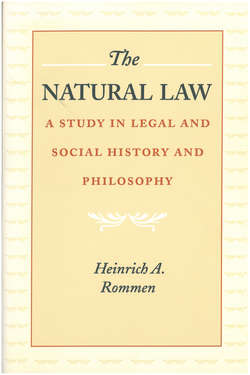The Natural Law

Реклама. ООО «ЛитРес», ИНН: 7719571260.
Оглавление
Heinrich A. Rommen. The Natural Law
Отрывок из книги
NIHIL OBSTAT
Matthaeus Britt, O.S.B.
.....
Thomas’s natural law theory had its greatest influence long after the Middle Ages. During the period of late scholasticism (roughly, the sixteenth and seventeenth centuries) Dominican and Jesuit theologians resurrected Thomas in order to respond both to the Reformation and to a series of international political crises. These crises were brought about by new and potent expressions of royal absolutism on the part of Protestant and Catholic sovereigns and by moral and political conflicts ignited by their colonial policies in the New World. In a period of civil wars and domestic disturbance, theories of royal absolutism were geared to enhance executive power. It is the recurrent story of natural law theory that it crops up precisely when the political order removes barriers to legislative and executive will.
Such is what happened during the Baroque era, where these issues were debated in the seminaries and in the courts of the Hapsburgs. Two centuries before the American Revolution, and nearly three centuries before the American Civil War, issues of political self-determination and slavery were debated in terms framed by Thomistic natural law theory. For example, the Dominican theologian Francisco Vitoria argued successfully for the natural rights of native peoples in the Indies and developed exacting criteria for the use of war by nations. His lectures, called the Relectiones (1527–40), influenced Hugo Grotius and the emerging modern jurisprudence of international law. Another Spanish Dominican, Bartolomé De Las Casas, whose Historia de las Indias (1561) was translated into several languages, worked and wrote tirelessly for the natural rights of Indians to political liberty and property. Consequently, the transition from medieval doctrines of natural law to modern conceptions of natural rights was achieved in no small part by Spanish scholastics.23
.....